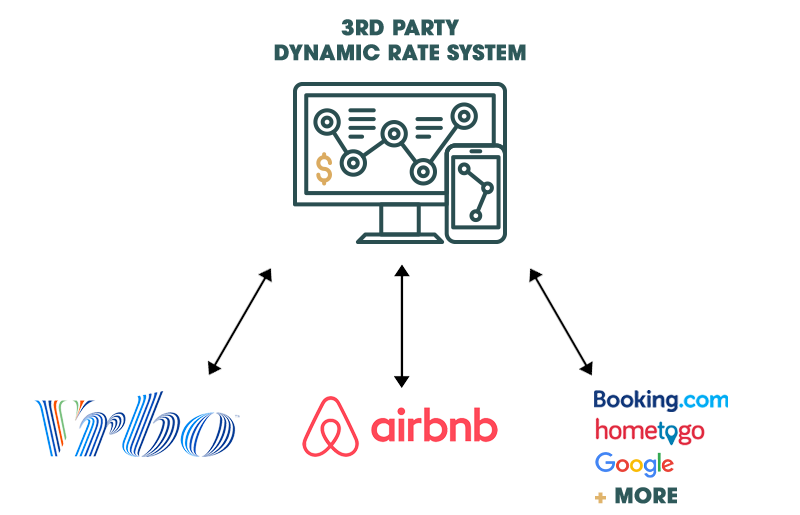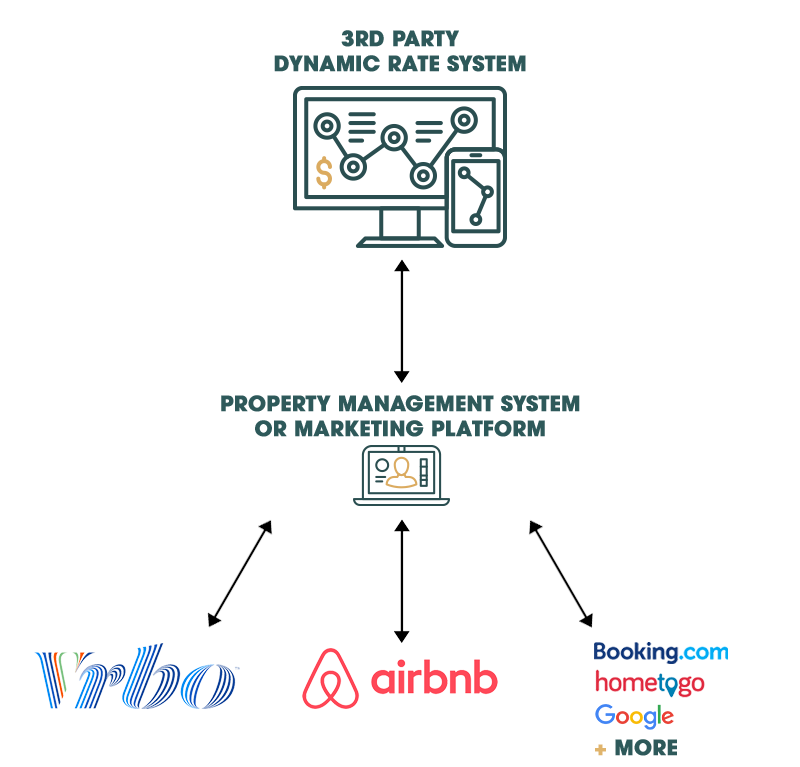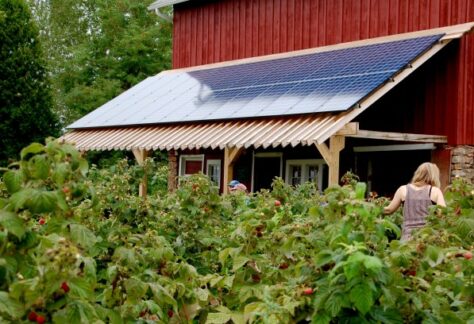How can you make more money on your Vacation Rental?
That is the golden question.
As an owner of a short-term or vacation rental, you’re wondering, “What should my average price be on Airbnb?” “What should my average price be on VRBO? “Will dynamic pricing help me make the most of my home?”
To make more money, ultimately you have two choices: either charge more or sell more nights. Revenue management is the practice of optimizing price and sales volume. The best revenue management strategy maximizes both price and occupied nights. Though on the surface you’re looking at two levers, either sell more or price higher, the reality is much more complex.
The key metric to measure the success of occupancy and price is RevPAR: Revenue per Available Rental. For an individual home, it looks like this:
| Occupancy | Average Daily Rate | RevPar |
| 1 home * 365 days per year | 1 home * 365 days per year | 1 home * 365 days per year |
| Occupied Annual Nights = 225 | Occupied Annual Nights = 225 | Occupied Annual Nights = 225 |
| 225/365 = 61.6% occupancy | 225/365 = 61.6% occupancy | 225/365 = 61.6% occupancy |
You could achieve a $123.20 RevPAR this way too:
75% * $164.38 = $123.20
To achieve $45,000 of income on your home, we all would prefer the higher rate and lower occupancy – less wear and tear on the home, less housekeeping expense, etc. Let’s just get one booking worth $45,000 and call it a day. But the reality is that your market and demand for your product drives your opportunity mix of occupancy and rates.
Seems simple, but why is it really so complex? Sophisticated pricing involves revenue management technology, and it has evolved tremendously over the last two years for the short-term rental space. Revenue management systems (RMS) that power market data, event data, or competitor home data that is input to a pricing algorithm have been around for decades in the hotel industry, but only recently have they translated to short-term rentals. Going back even 5 years, studies showed that applying RMS to hotels led to a 3 – 17% increase in revenue, and that number is likely higher for short-term rentals (Source: Hospitality Upgrade).
Here are a few reasons why pricing can be difficult to get right.
As traveler shopping and buying behaviors shift, depending on your market, there is a chance your home might be even competing against a hotel. Depending on the reason for travel and needs of the travelers, understanding the pricing climate of the entire lodging segment may be relevant to you. You actually might be able to shift market share away from hotels.
DEMAND
The more demand you can generate, the higher you can price – simple supply and demand, right? For example, if 80% of the demand for your home is searching for a 2 or 3 night stay, if you place a 4-night minimum on your home you will only have access to 20% of all demand. Another scenario might be that 50% of all travelers are looking for a pet friendly home and if you’re home is not pet friendly you may be missing out.
BOOKING WINDOW
If the majority of travelers book 30 days out, and you discount your price within 30 days before arrival it may be too late to capture any bookings. At this point, there is very little demand. This is called a booking curve, and understanding price point accuracy at a certain time prior to arrival can also make or break it for you.
SHOULDER NIGHTS
Though the majority of your demand might be on weekends, there is always some demand for other days of the week. If you can price those unfilled nights more aggressively, you may improve your chances of capturing the longer length of stay guest and filling the holes in your calendar. Why not price Wednesdays lower?
SUPPLY
One of the most interesting factors in the short-term rental space is the constantly changing supply. For example, last July there may have been 100 total 3-bed homes in your market, but this July there are now 200 homes. This might not be an issue if there is a special event bringing additional demand, but if this tips the scale and supply has outpaced demand growth, it could be much more competitive.
You can see how quickly, what seems like a simple equation of sell more or charge more really includes many factors. This leads us to the next question.
Should I Use Dynamic Pricing Technology?
Today, there are revenue management systems that integrate seamlessly with the common short-term rental channels and automate daily rate updates for you. These systems require human configuration to ensure you have appropriate settings in place, but after the set-up phase maintenance is much easier and your pricing strategy will be more intelligent and fluid. Here are a few factors that should be considered when determining whether to use pricing technology.
SYSTEM LEVEL OF CONTROL
With every good system, you should have the ability to put settings in place that make you comfortable. If too much is controlled by the system without human input or enough visibility, the system may drive higher occupancy vs price, leaving money on the table for you. Again, these systems and tools are quickly evolving and adding new features, and it’s always good to stay current with any technology you choose.
SEASONAL OCCUPANCY
If your home is located in a very seasonal market, where only 3 months of the year have the potential to go above 40% occupancy. You may not see a large return on a revenue management system investment. Though understanding the 3-months of your high season and getting those rates right is critical, if you carve out the time to review rates daily it might be possible to fully maximize RevPAR without a system.
DIVERSE SUPPLY AND FAST-CHANGING DEMAND
For any larger city center, or overall busier market with hotel, home, or furnished apartment supply, the complexity of pricing may require more than what is humanly possible. In a market like this, within 48 hours, the climate can change quickly and without technology you might miss the opportunity to take your $300 price to $500…leaving real money on the table. For example, these types of real-time RMS technologies power things like Uber surge pricing. The system tracks activity and automatically raises rates.
MORE THAN ONE HOME
If you self-manage and own more than one home, this is more likely worth the investment regardless of your market dynamics. If you’re using a property manager it’s worth asking how they apply revenue management practices to their business. If they manage a large portfolio manually, that may be a concern if business processes aren’t in place to price in a nimble way via human resources.
What are the Revenue Management System Options?
Airbnb and VRBO have a built-in price recommendation capability, but there are many options available now to use a 3rd party system that integrates seamlessly to multiple channels at once. Here is a quick summary:
AIRBNB SMART PRICING >>
This tool is providing a recommended price and seamlessly updating Airbnb. It is described on the website as: “Smart Pricing lets you set your prices to automatically go up or down based on changes in demand for listings like yours. You’re always responsible for your price, so Smart Pricing is controlled by other pricing settings you choose, and you can adjust nightly prices any time. Smart Pricing is based on the type and location of your listing, the season, demand, and other factors.” And interestingly, it is not available for anyone in Spain.
VRBO MAREKTMAKER >>
The revenue management toolbox and teams at VRBO have been influenced by Expedia in recent years as well. Similar to Airbnb,, this tool is recommending a price and seamlessly updating VRBO. VRBO describes it like this: “MarketMaker™ can help you set – and stick to – a revenue management strategy that brings you closer to your goals. For any given night, MarketMaker shows you both supply (the percent of unbooked properties in your market) and demand (the volume of traveler searches) data in your market. It even shows you a calendar of local events and holidays that may influence demand in your area. It also compares your rate to the average rates of other properties in your area so that you can see how you measure up. In short, it gives you all the data you need to adjust your revenue management strategy. If you set a revenue management strategy in MarketMaker, the tool will even notify you when there’s an opportunity to get closer to your goal. For example: You set your strategy to maximize revenue. When MarketMaker sees that there’s high demand (many travelers searching for a property in your area) but low supply (few available properties) in your market, it may suggest that you increase your rate.”
3RD PARTY DYNAMIC PRICING TOOLS
These providers use data from multiple different sources as input to their pricing algorithms. Beyond Pricing and Pricelabs are a few of the lead vendors in this space. Layering the market data with your system configurations, the system then recommends a price. That price can be updated daily for the next 365 days or more depending on the system you choose. These systems then serve as your pricing system of record and push rates one of two ways:


In addition to all of the revenue management factors mentioned above, believe it or not, there is still more.
- Things like cancel policies, amenities, or inclusions can also impact your ability to convert a shopper into a booker.
- Do you have full distribution? If you only offer your home on Airbnb, but 40% of all shoppers in your market never go to Airbnb, you are missing out on demand and a chance to price higher. Remember, more demand = more pricing power.
- Page placement and special tagging on distribution channels, as well as guest reviews can also have a big impact on your pricing power.
- VRBO and Airbnb offer ways to run promotions and actually get merchandising (tags, preferred placement, etc) with strategic discounting and advertising. VRBO’s new promotional capability seems to be based on Expedia’s success, so we’ll have to watch how the VRBO promotional product evolves and gains traction. Booking.com also offers ways to get discounted, promotional tagging and more exposure.
- In addition to RevPAR, new concepts like bedroom optimization are being included. What is your revenue per available bedroom? This becomes a revenue management focus if you are using a per person fee. Similar to restaurant revenue management, you can sell every table, but can you sell every seat? You’d rather not seat 2 people at the 6-top and turn away a larger party.
Pricing capabilities are evolving across all industries. From your highway digital toll price fluctuations based on traffic patterns, to different gas prices for the same grade gasoline based on your form of payment, dynamic pricing truly is everywhere and it’s not going away.
Revenue management is a ton of fun and can be considered both an art and a science. Stay tuned as dynamic pricing continues to evolve for short-term and vacation rentals.
Content Contributed By:

Heather Richer
Heather Richer has a broad background in lodging with experience in both short-term rentals and hotels. She is passionate about revenue management, and currently serves on the Revenue Management Advisory Board for HSMAI. Having been involved with other organizations like AHLA, HEDNA, and VRMA, she sees the value in education and unbiased resources needed for the underserved community of short-term rental homeowners. Heather is currently Principal, Richer Logic Consulting and previously was CMO of RedAwning. Prior to that, she served as VP, Revenue Management and Distribution at Kimpton Hotels and Restaurants. She holds her Masters in Tourism Administration from George Washington University.





